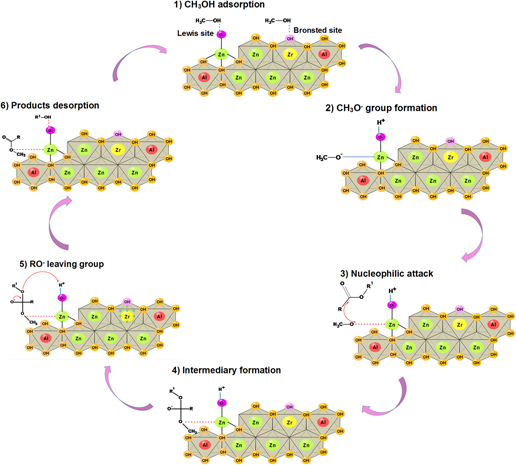Crossref Citations
This article has been cited by the following publications. This list is generated based on data provided by
Crossref.
Cabrera-Munguia, Denis A.
González, Horacio
Barreto-Gutiérrez, Mónica
Gutiérrez-Alejandre, Aída
Rico, José L.
and
Solís-Casados, Dora A.
2020.
Tuning the Basic Properties of ZnAl Hydrotalcites Modified with Ce Applied to Transesterification of Soybean Oil.
Catalysis Letters,
Vol. 150,
Issue. 7,
p.
1957.
Qu, Tongxin
Niu, Shengli
Zhang, Xiangyu
Han, Kuihua
and
Lu, Chunmei
2021.
Preparation of calcium modified Zn-Ce/Al2O3 heterogeneous catalyst for biodiesel production through transesterification of palm oil with methanol optimized by response surface methodology.
Fuel,
Vol. 284,
Issue. ,
p.
118986.
Hashemzehi, Mojgan
Pirouzfar, Vahid
Nayebzadeh, Hamed
and
Su, Chia‐Hung
2022.
Modelling and optimization of main independent parameters for biodiesel production over a Cu0.4Zn0.6Al2O4 catalyst using an RSM method.
Journal of Chemical Technology & Biotechnology,
Vol. 97,
Issue. 1,
p.
111.
Kumari, Sonika
Sharma, Ajay
Kumar, Satish
Thakur, Abhinay
Thakur, Ramesh
Bhatia, Shashi Kant
and
Sharma, Anil Kumar
2022.
Multifaceted potential applicability of hydrotalcite-type anionic clays from green chemistry to environmental sustainability.
Chemosphere,
Vol. 306,
Issue. ,
p.
135464.
Sharma, A.
Kumari, S.
Sharma, S.
Singh, T.
Kumar, S.
Thakur, A.
Bhatia, S.K.
and
Sharma, A.K.
2023.
Layered double hydroxides: an insight into the role of hydrotalcite-type anionic clays in energy and environmental applications with current progress and recent prospects.
Materials Today Sustainability,
Vol. 22,
Issue. ,
p.
100399.
Grainca, Arian
Boccalon, Elisa
Nocchetti, Morena
Vivani, Riccardo
Di Michele, Alessandro
Longhi, Mariangela
and
Pirola, Carlo
2024.
Sonochemical and mechanochemical synthesis of iron-based nano-hydrotalcites promoted with Cu and K as catalysts for CO and CO2 Fischer-Tropsch synthesis.
Fuel,
Vol. 373,
Issue. ,
p.
132303.
Huang, Chengcheng
Yang, Ying
Wang, Pingjing
Fu, Hongchen
Hu, Xin
Zhou, Yunshan
Zhang, Lijuan
and
Zhong, Yuxu
2025.
Synergistic Acid‐Base Action Leads to Ultrafast Decontamination of Nerve and Blister Agents by OH− Intercalated Zr4+‐Doped MgAl‐LDH under Ambient Conditions.
Advanced Materials,
Vol. 37,
Issue. 5,
Zeng, Yongjian
Wang, Yuchen
Lin, Lu
Hu, Di
Jiang, Zhiwei
Luque, Rafael
and
Yan, Kai
2025.
Layered double hydroxides-based nanomaterials for biodiesel production.
Renewable and Sustainable Energy Reviews,
Vol. 218,
Issue. ,
p.
115807.
Soni, Savita
Kumari, Sonika
Sharma, Ajay
Bhatia, Shashi Kant
and
Sharma, Anil Kumar
2025.
Tetravalent metals modulated Zn-based layered double hydroxides and their mixed metal oxides for catalytic depolymerization of carbonyl-coordinating plastic waste.
Catalysis Today,
Vol. 446,
Issue. ,
p.
115136.
Calangi, Jeraldine Docil
Tago, Teruoki
and
Kimura, Kentaro
2025.
Calcined hydrotalcite-coated ZSM-5 with acidic and basic bifunctionalities for 5-hydroxymethylfurfural production from glucose.
Chemical Engineering Journal,
Vol. 519,
Issue. ,
p.
165013.
Cabrera-Munguia, Denis A.
Solís-Casados, Dora A.
Romero-Galarza, Adolfo
Gutiérrez-Alejandre, Aída
Ríos-González, Leopoldo J.
and
López-Montes, Raquel A.
2025.
Assessment of Biodiesel Production from Ricinus Communis Oil over Based Zinc and Aluminum Hydrotalcites Modified with Calcium.
BioEnergy Research,
Vol. 18,
Issue. 1,


